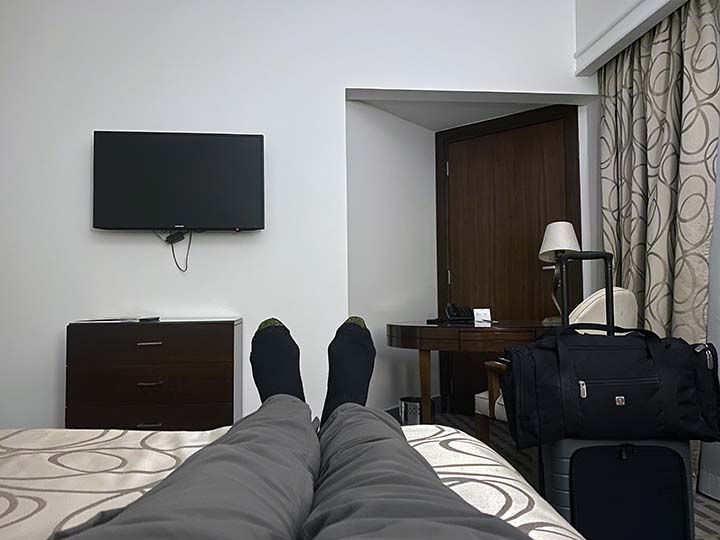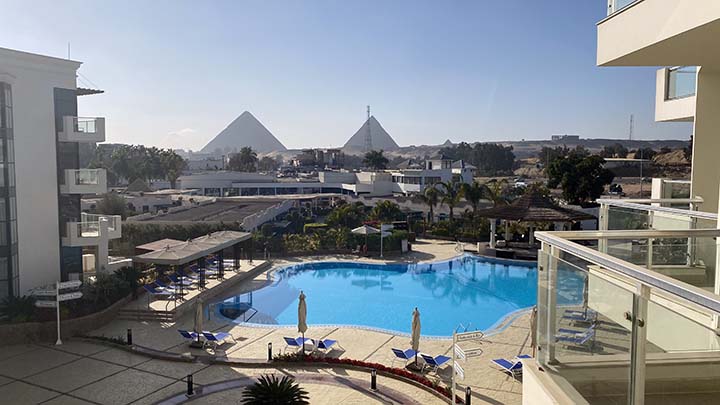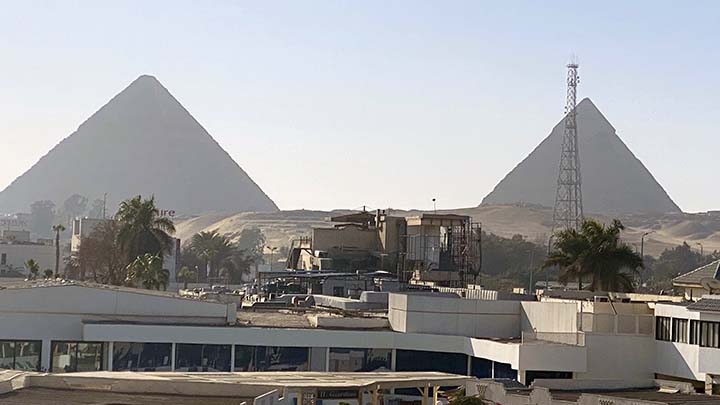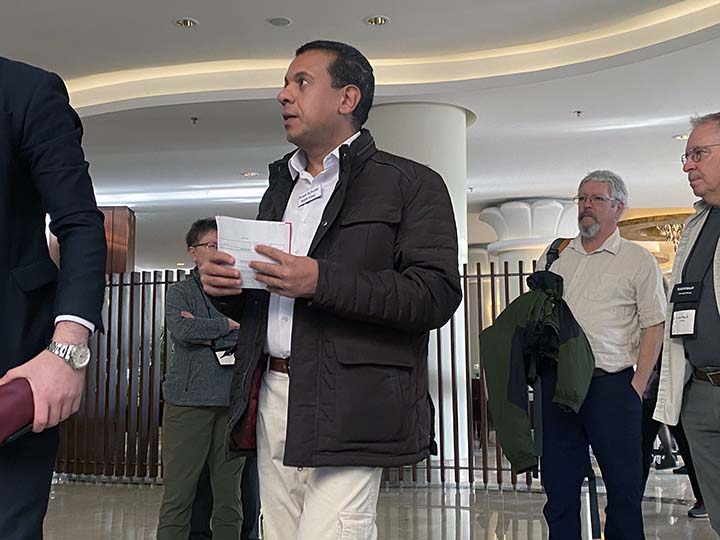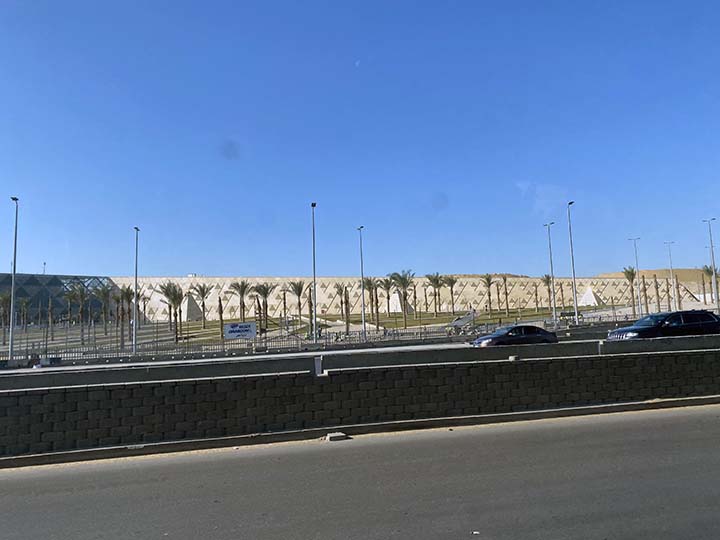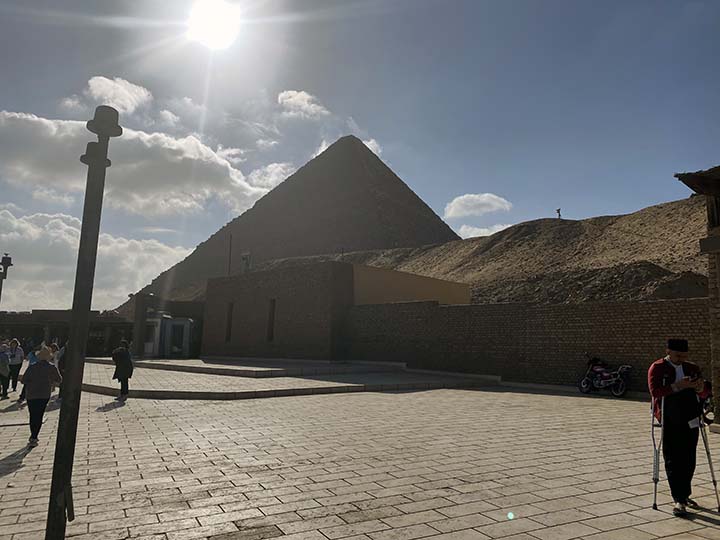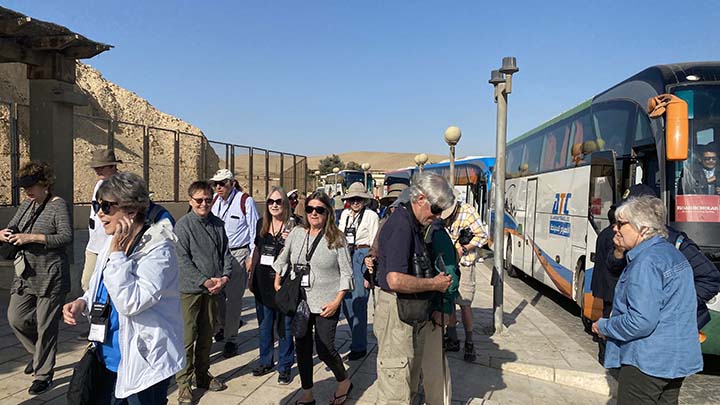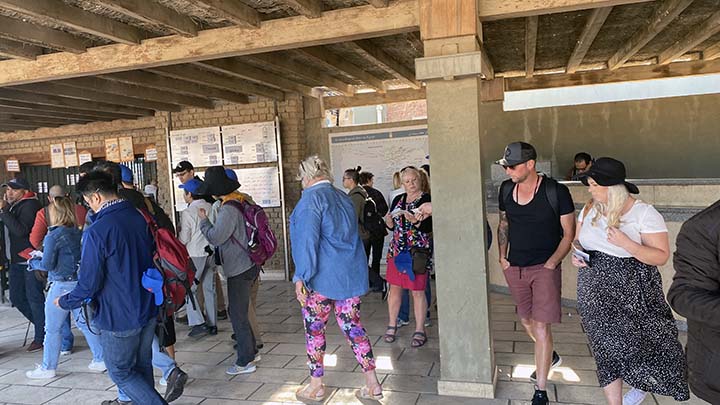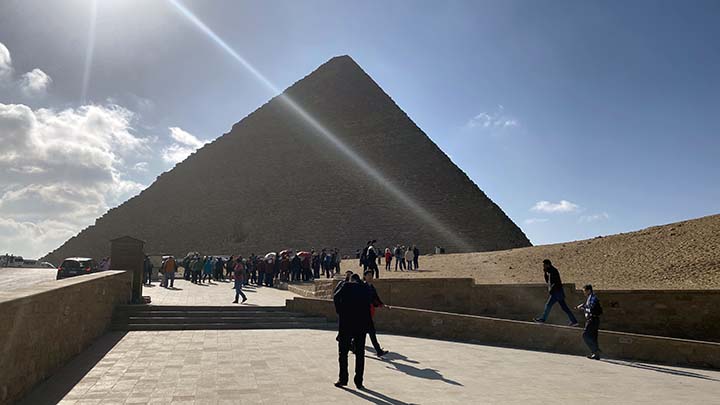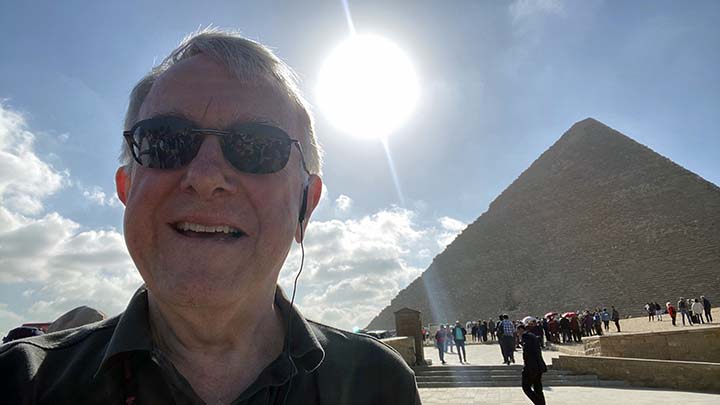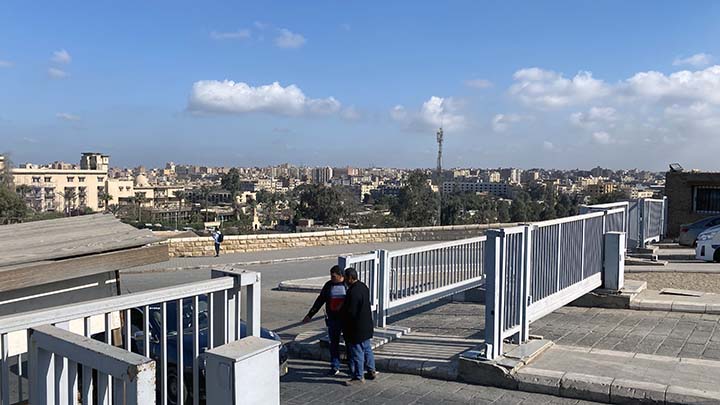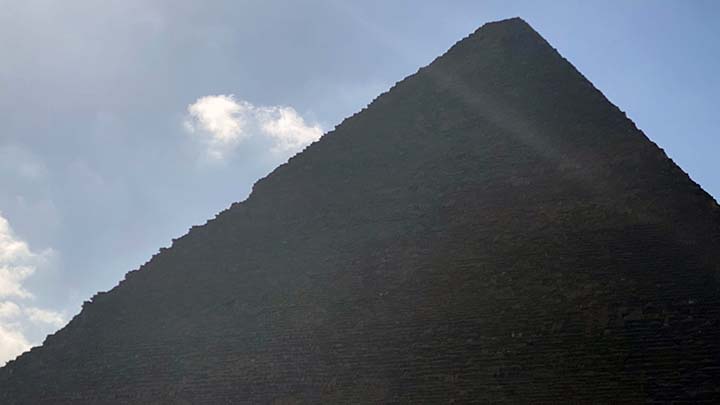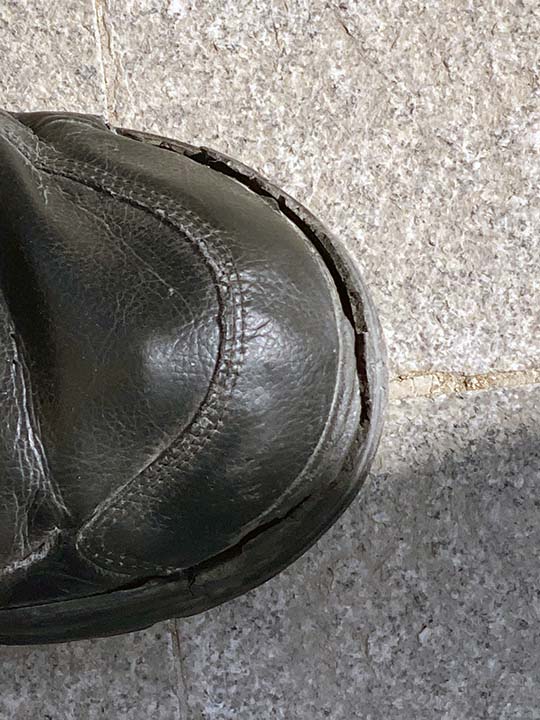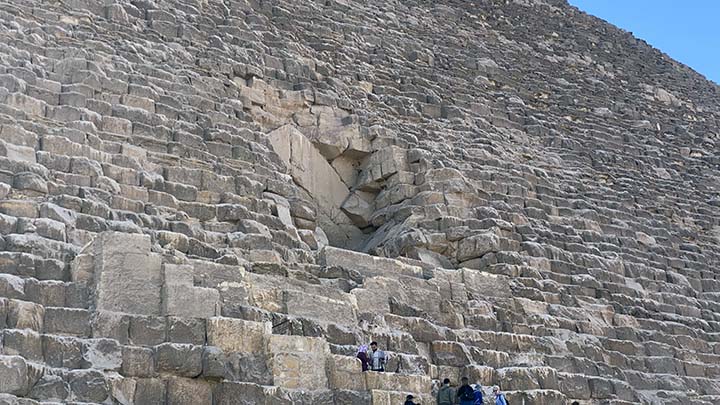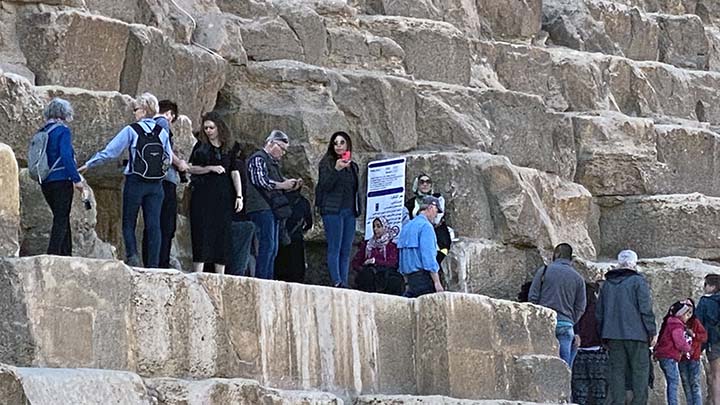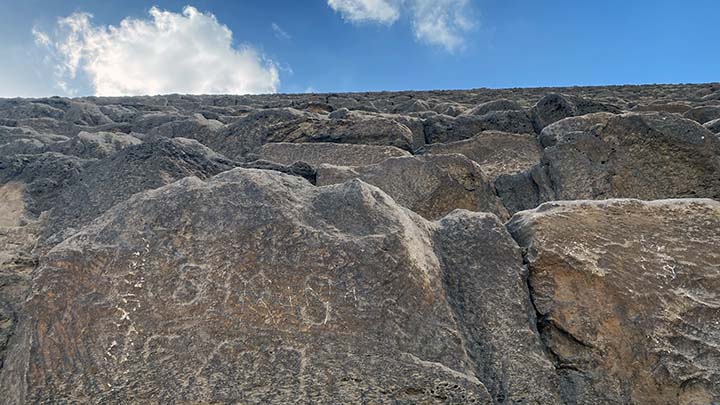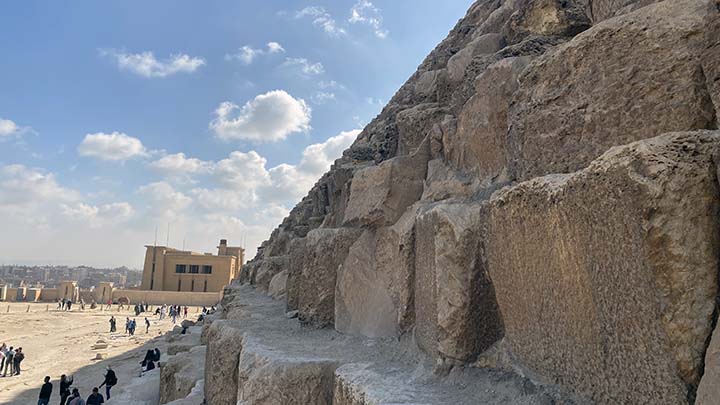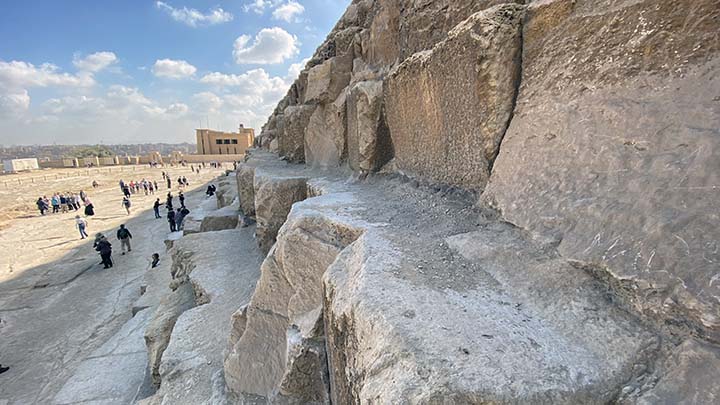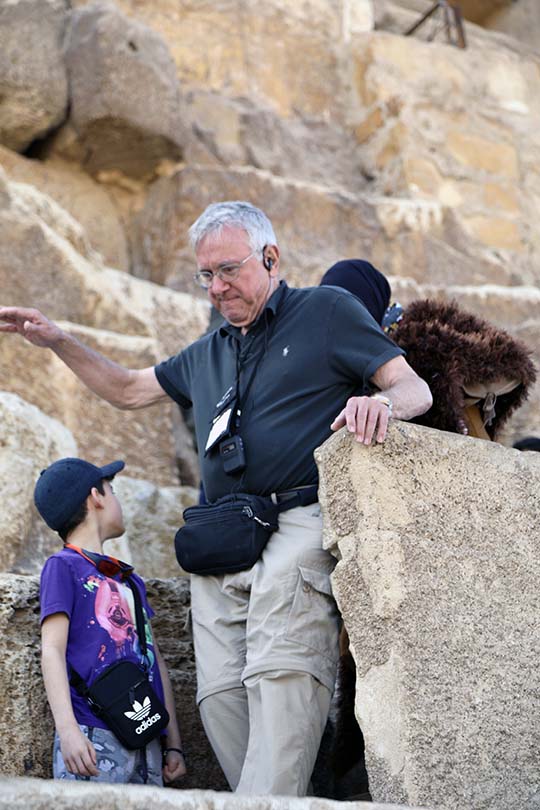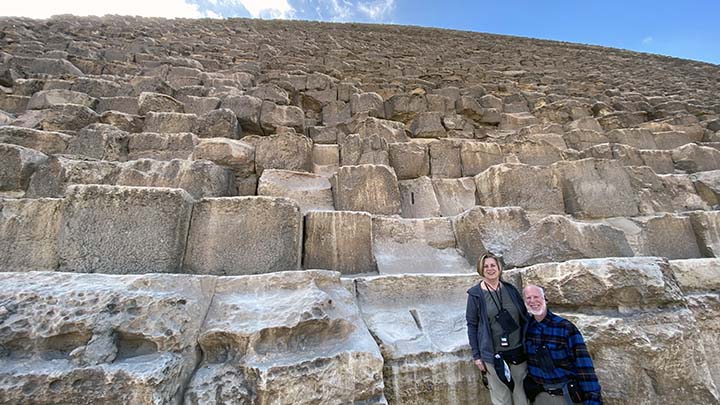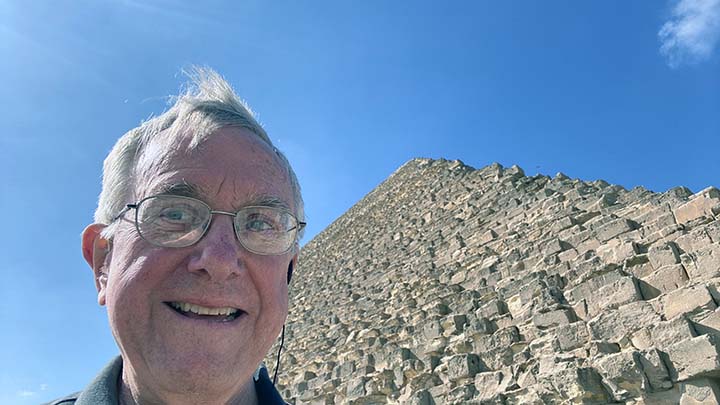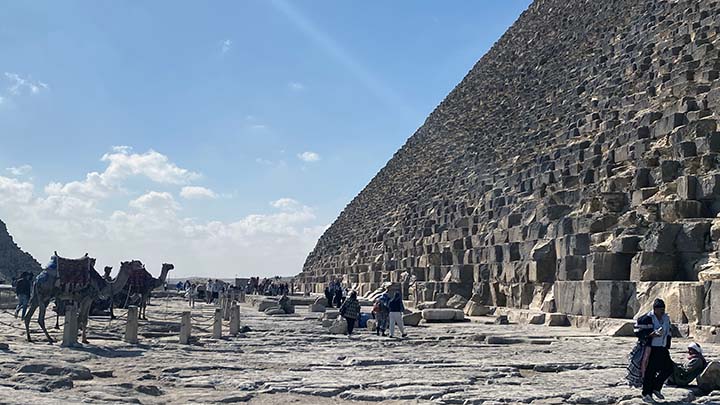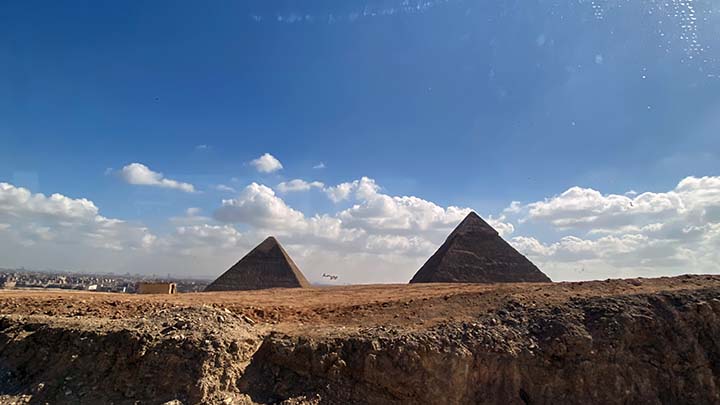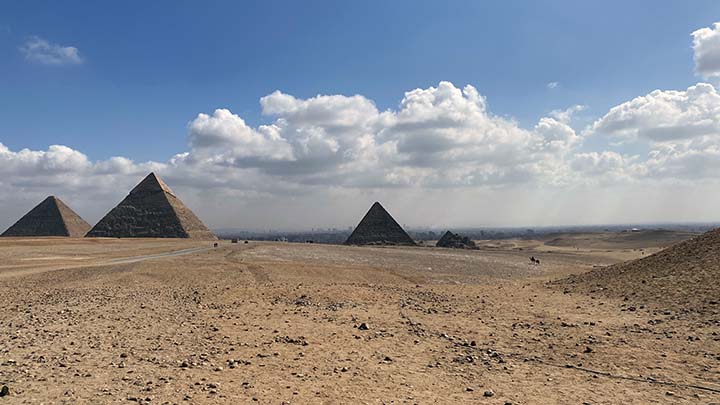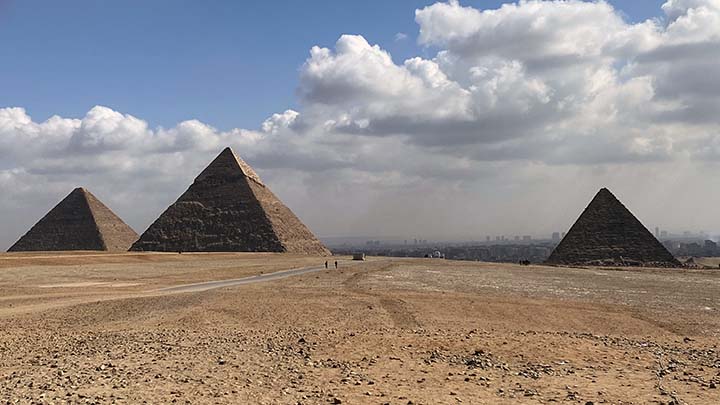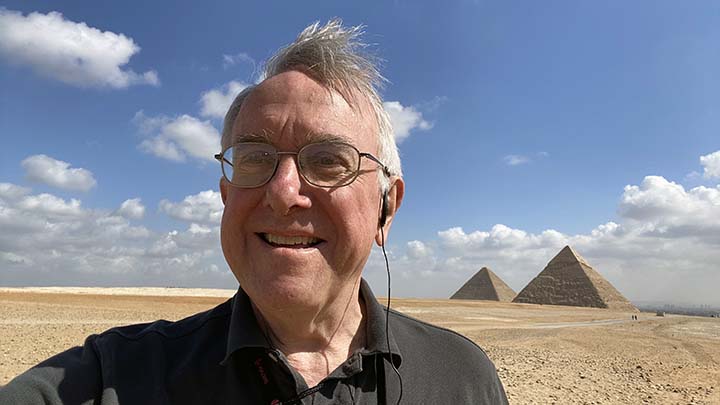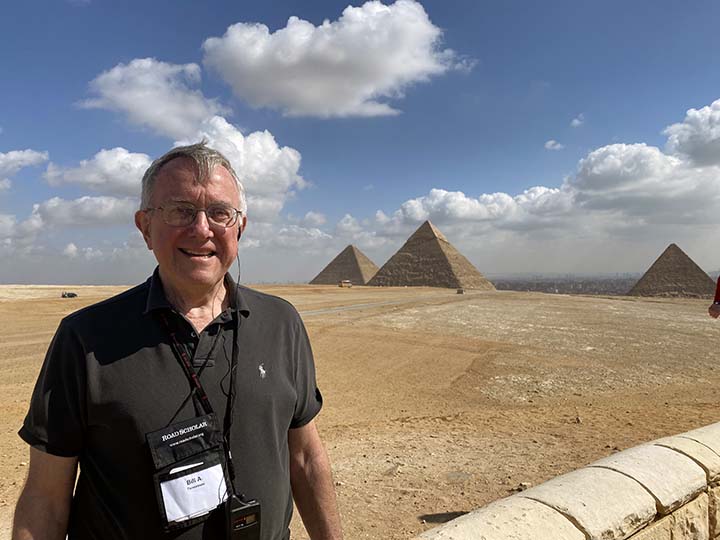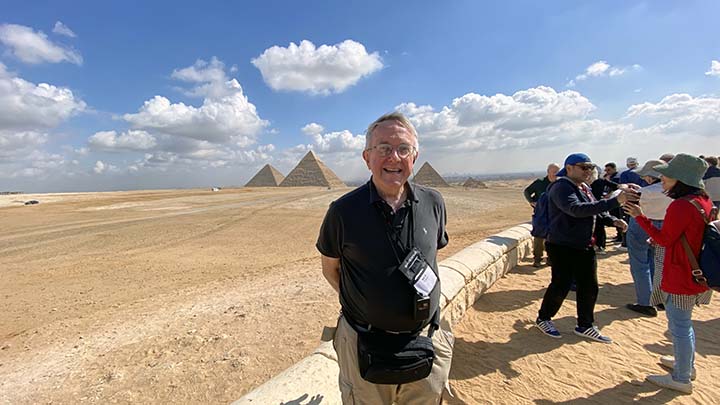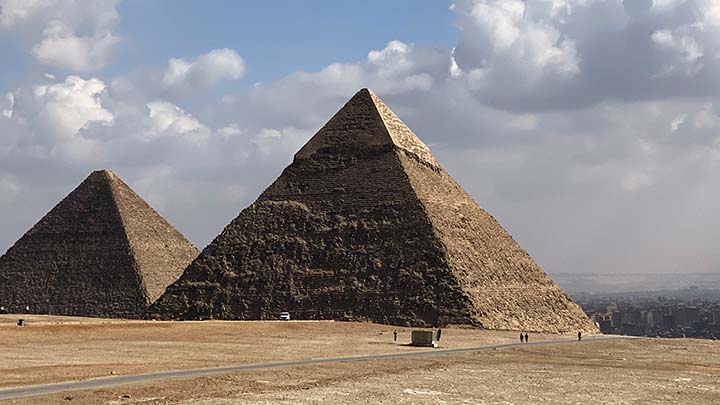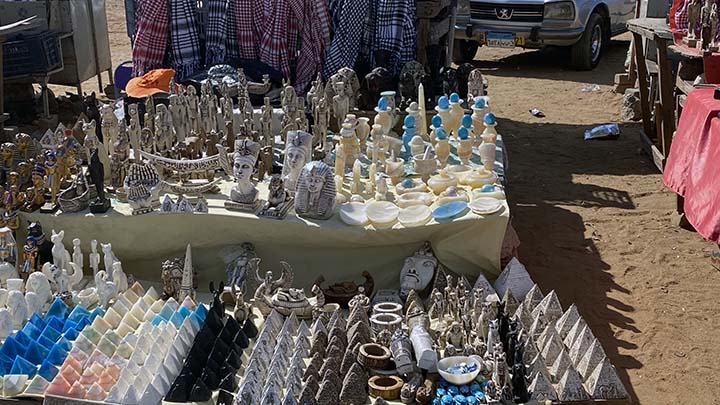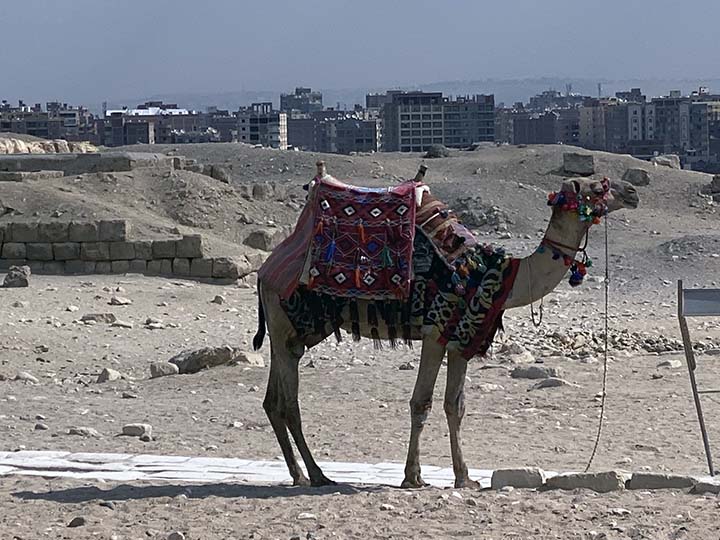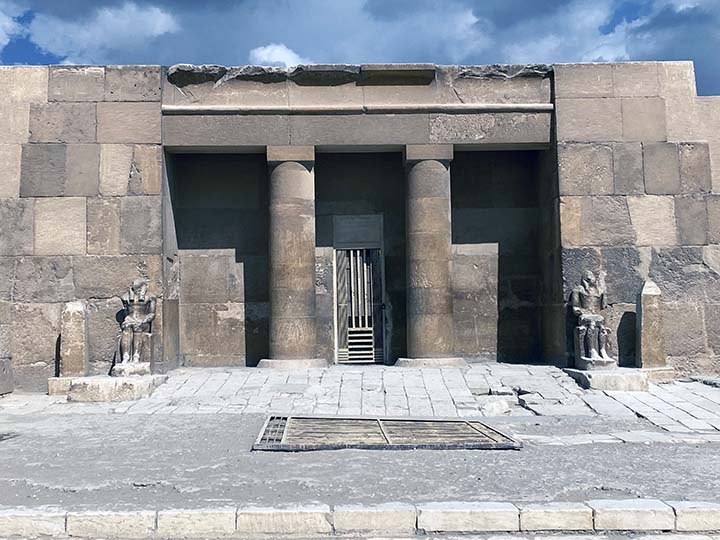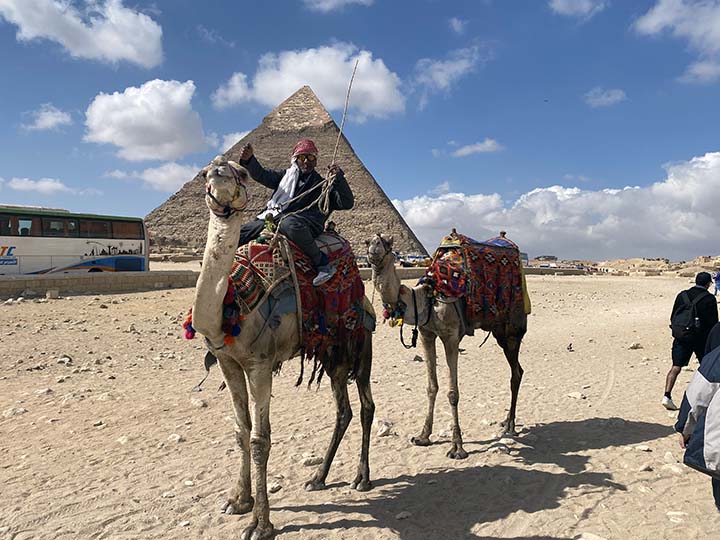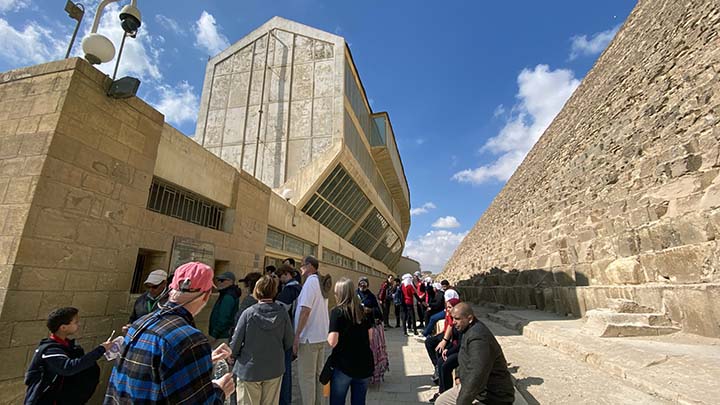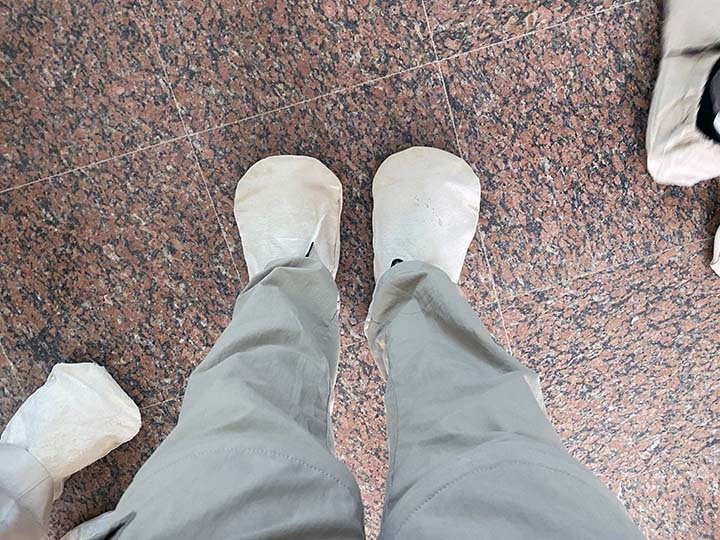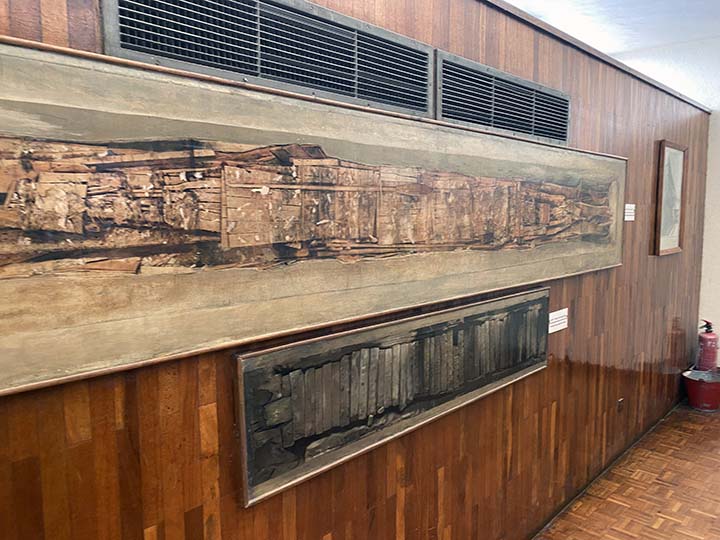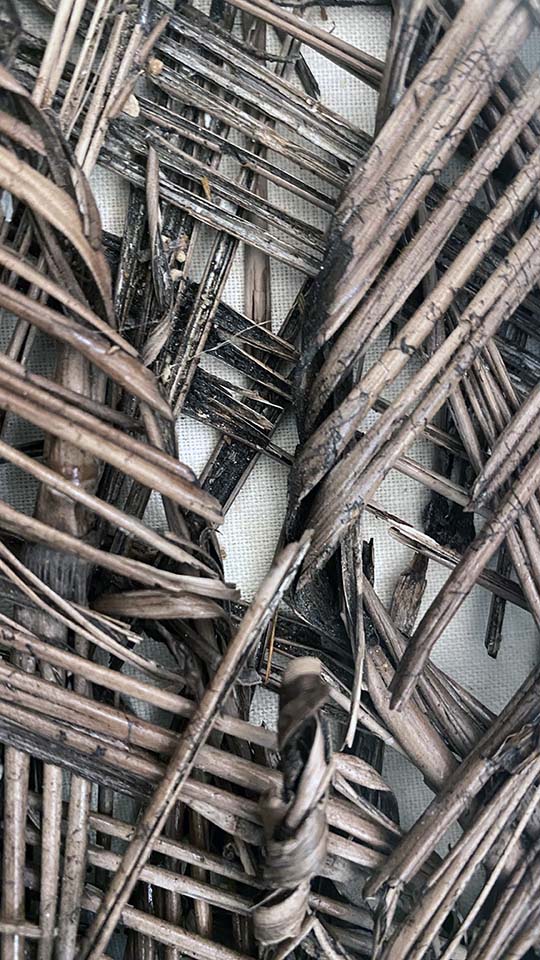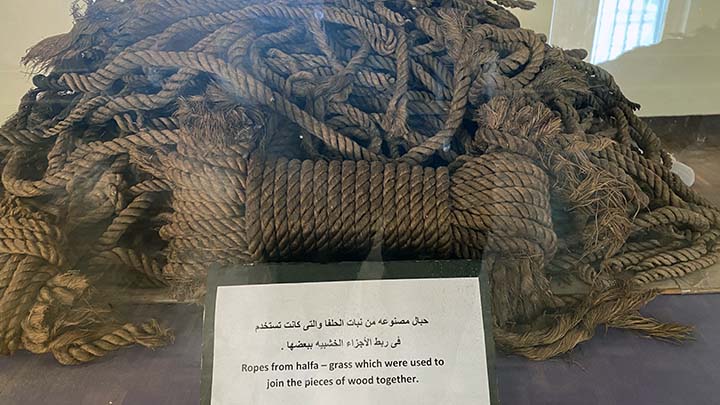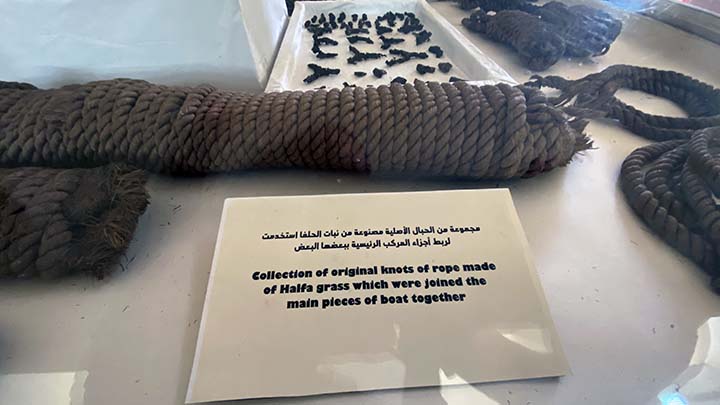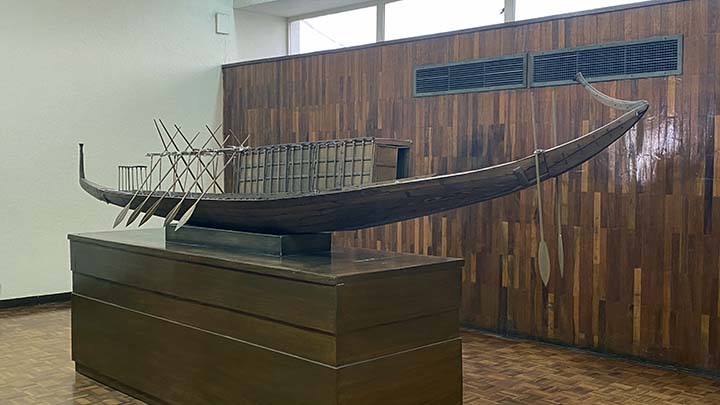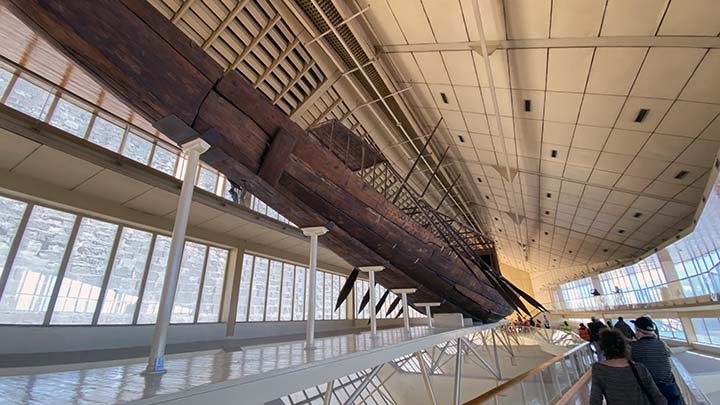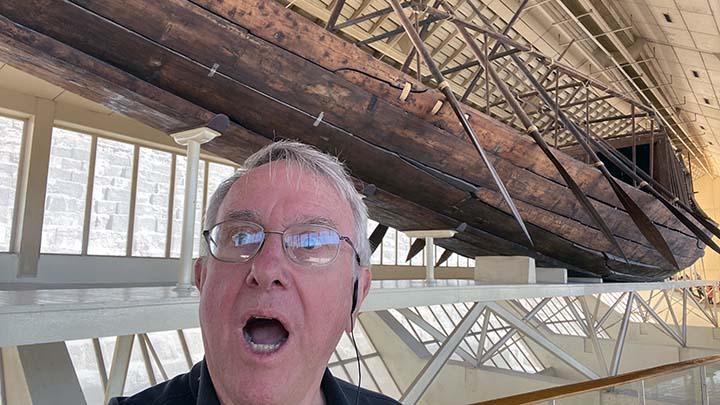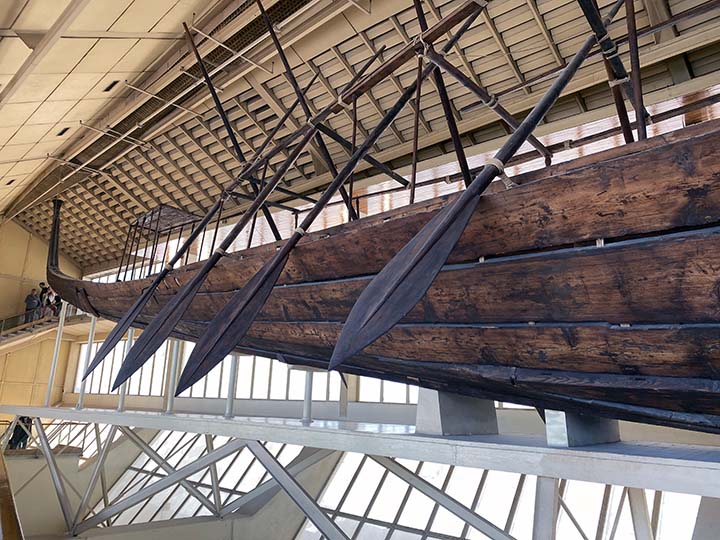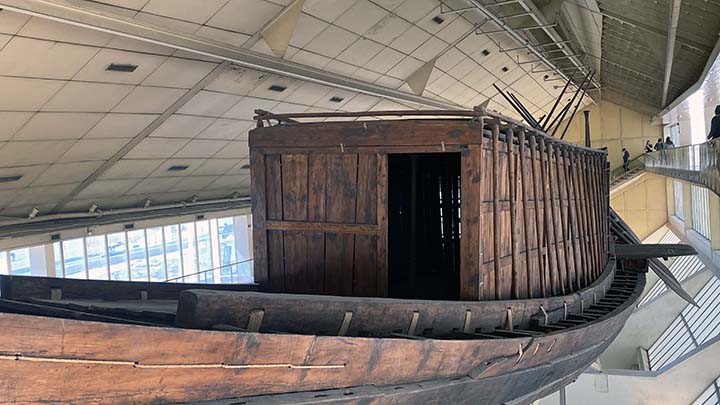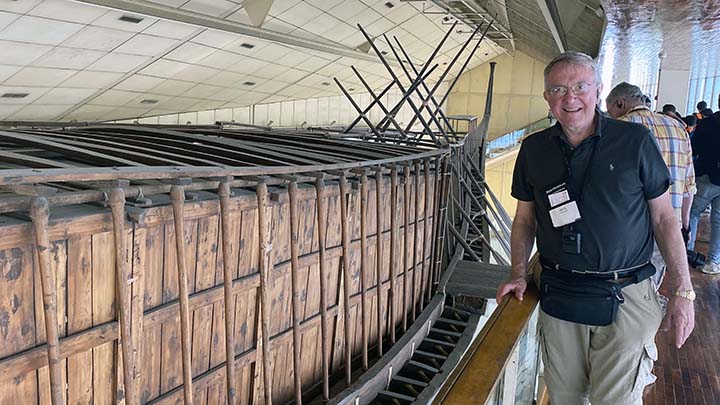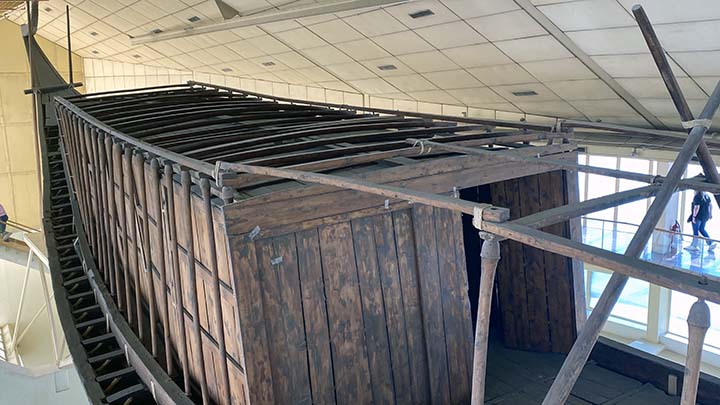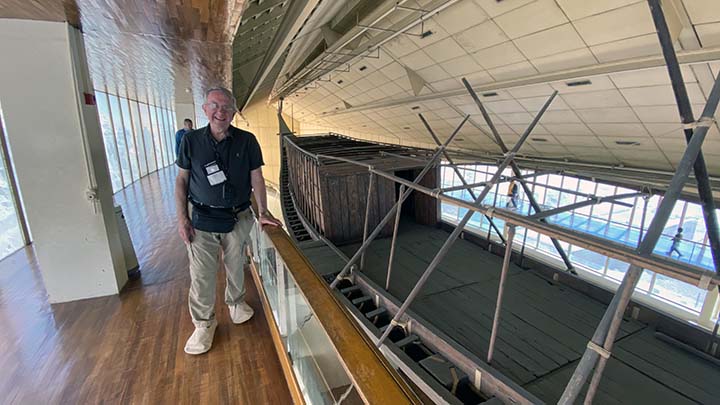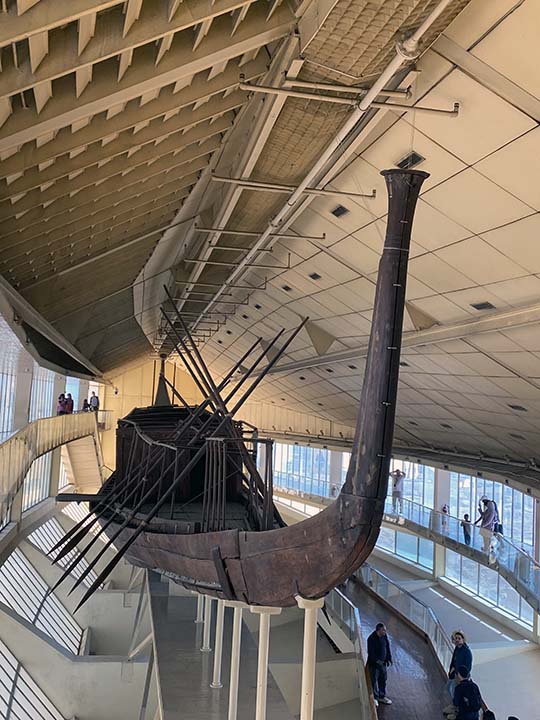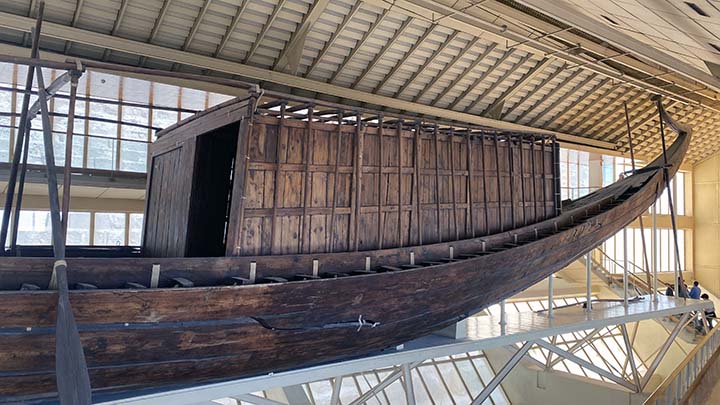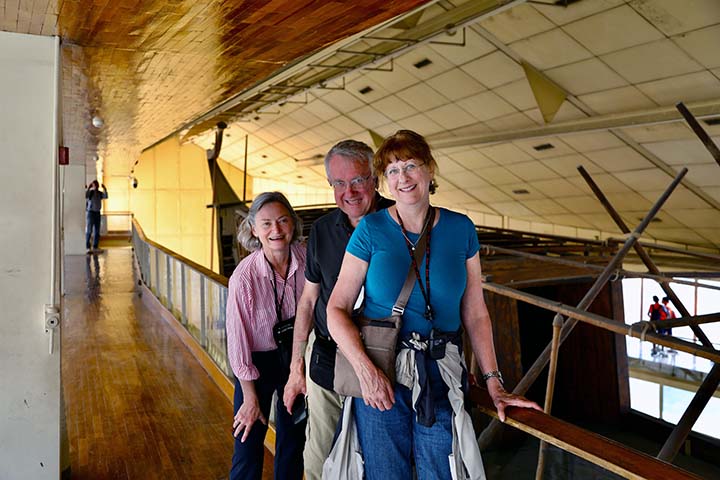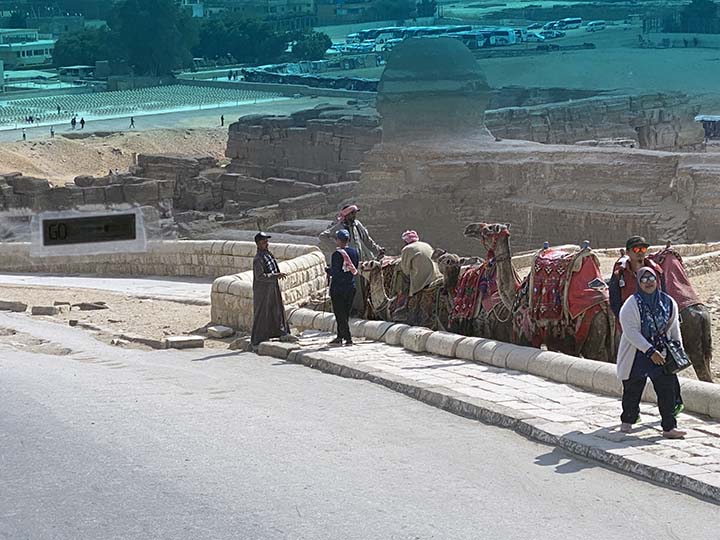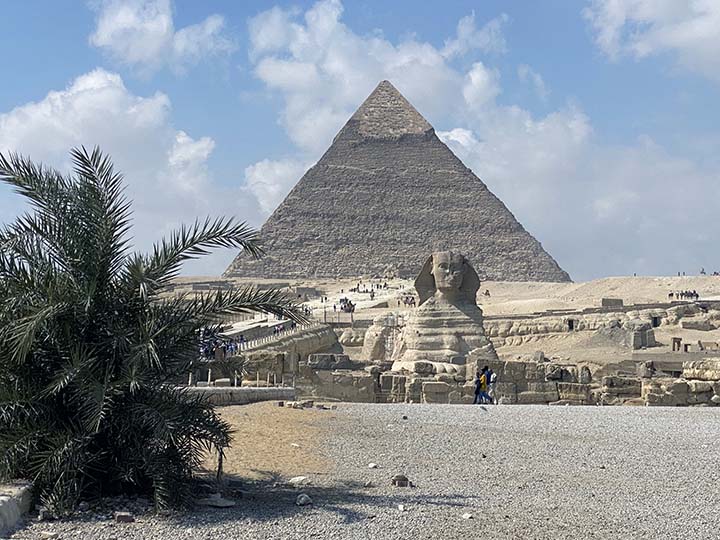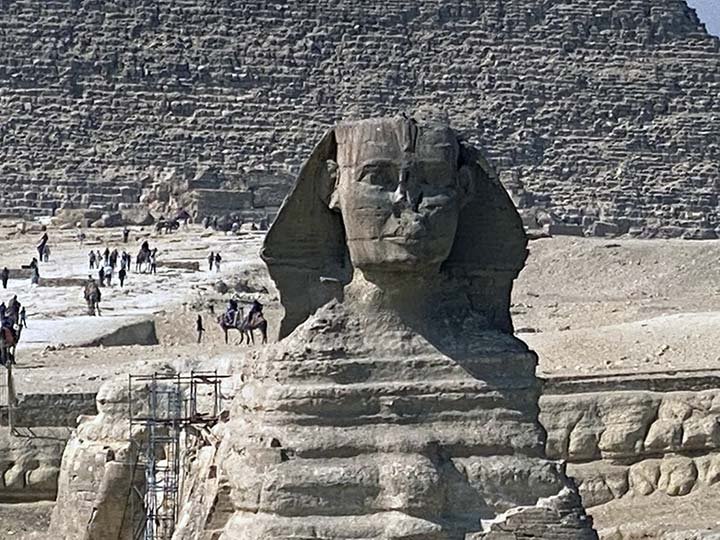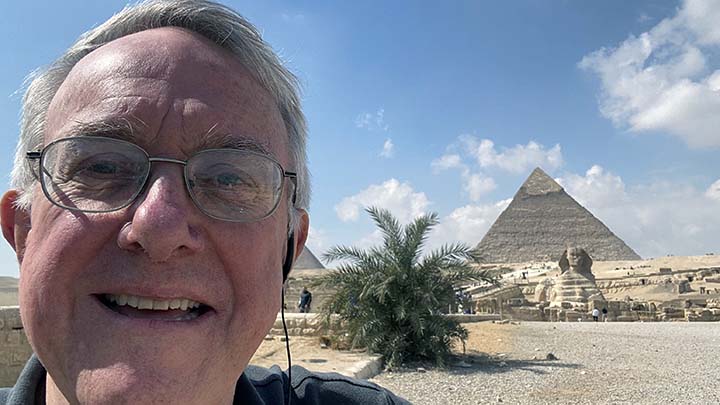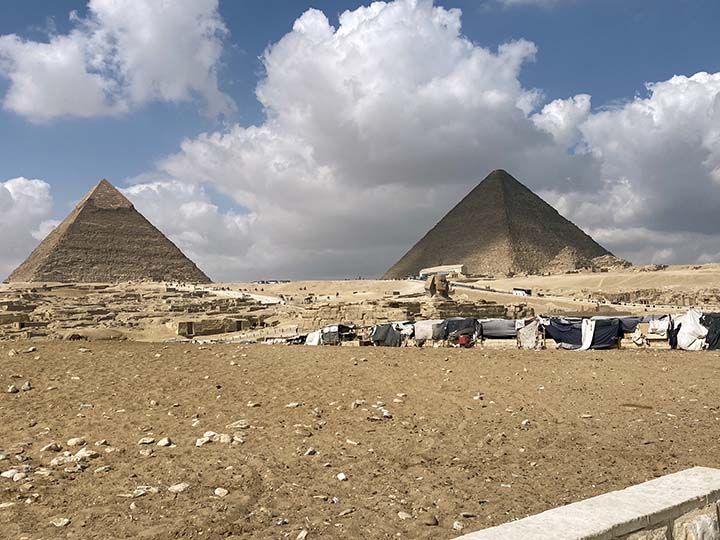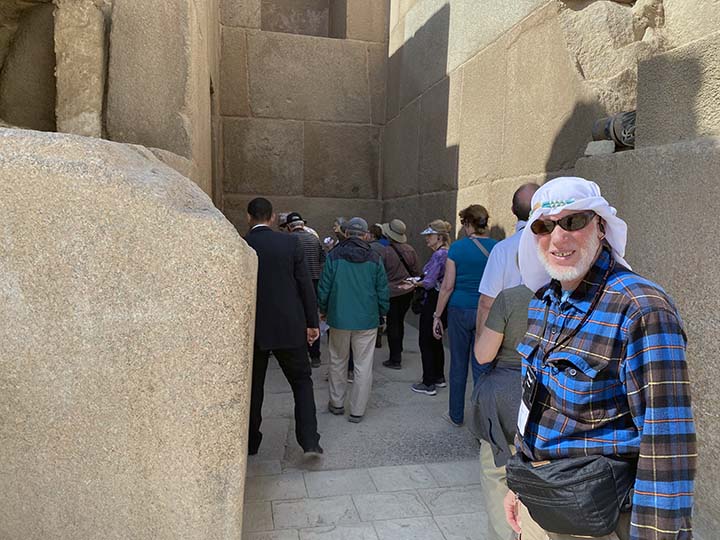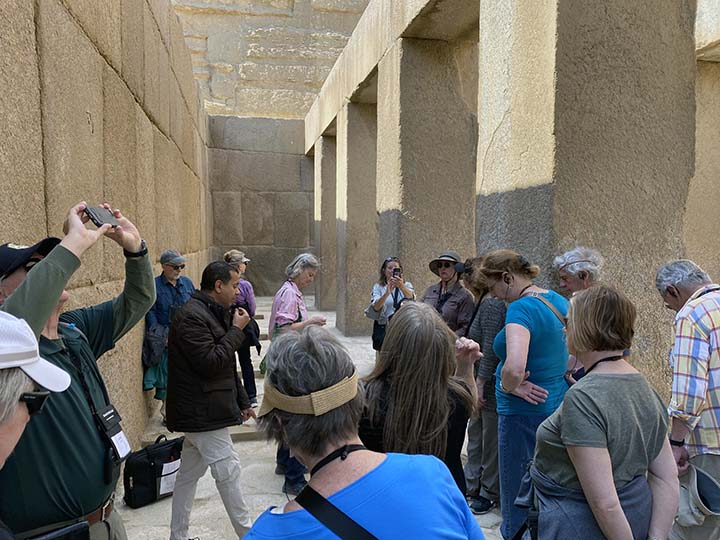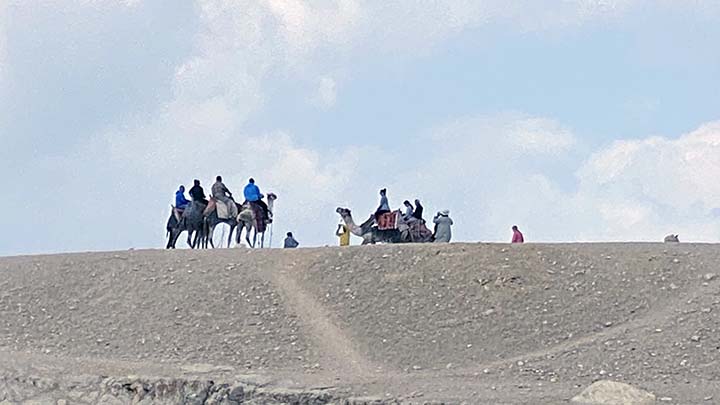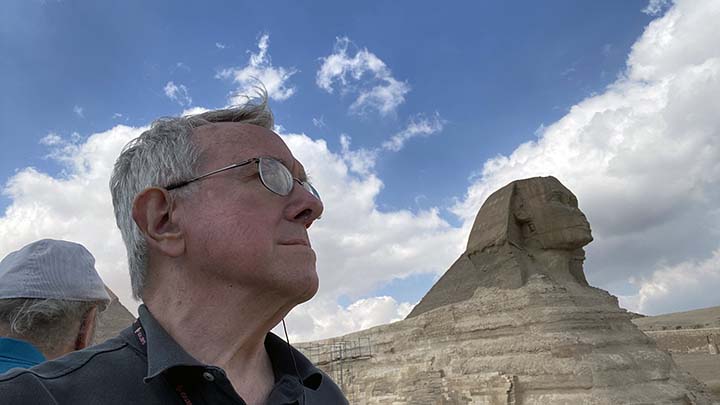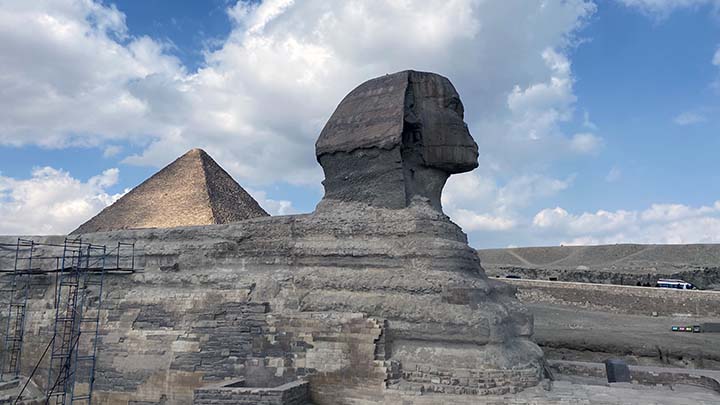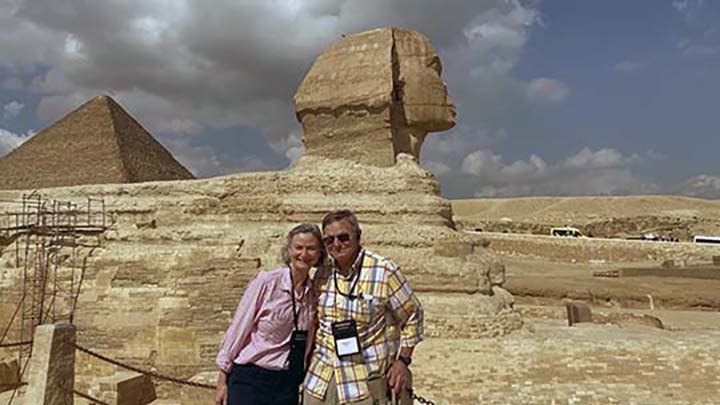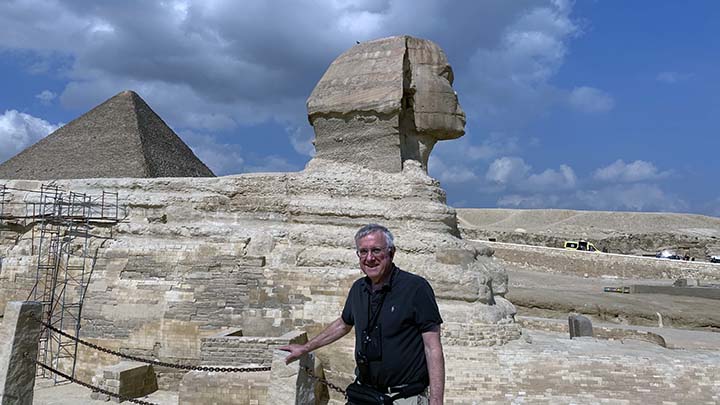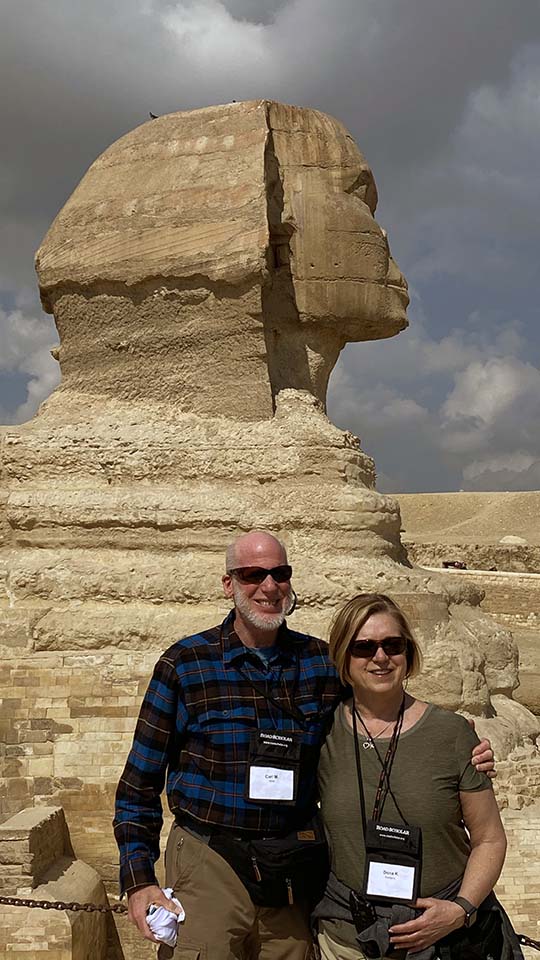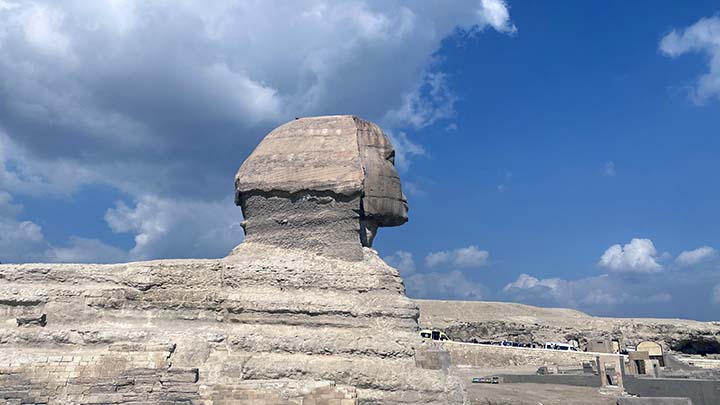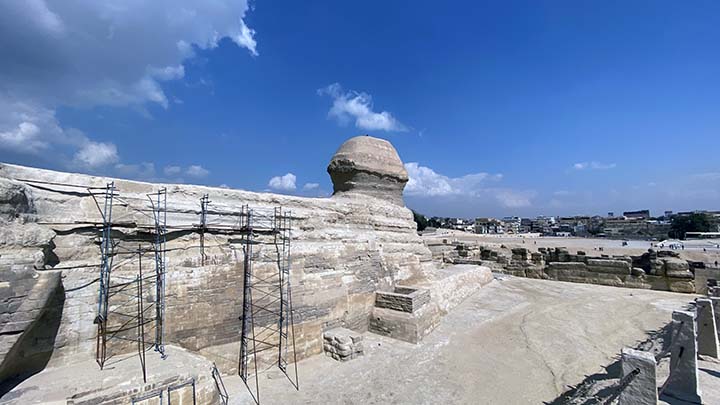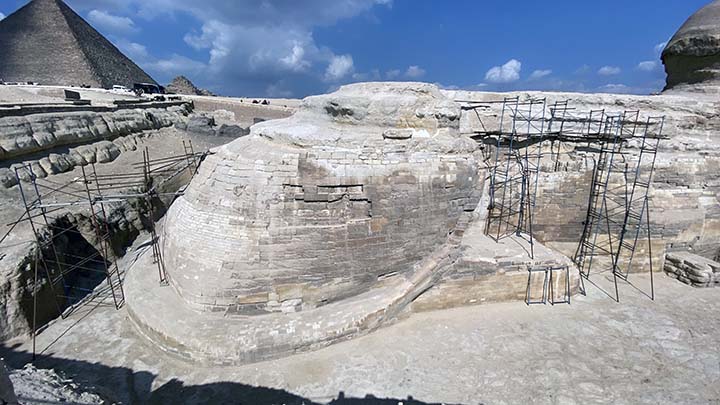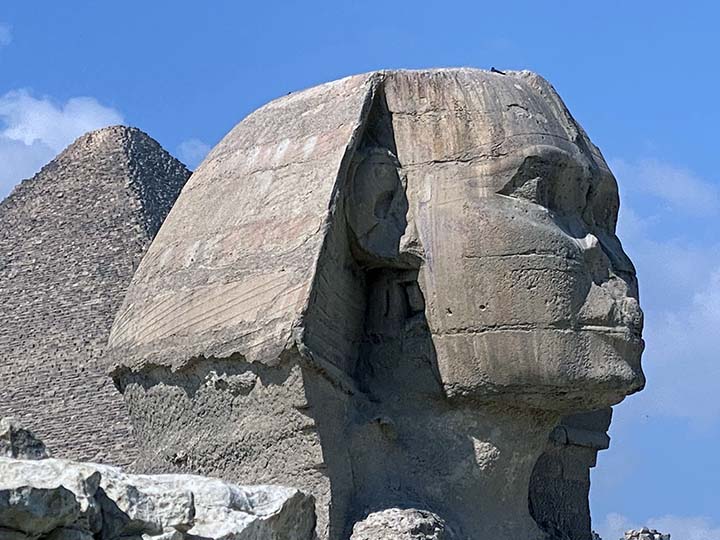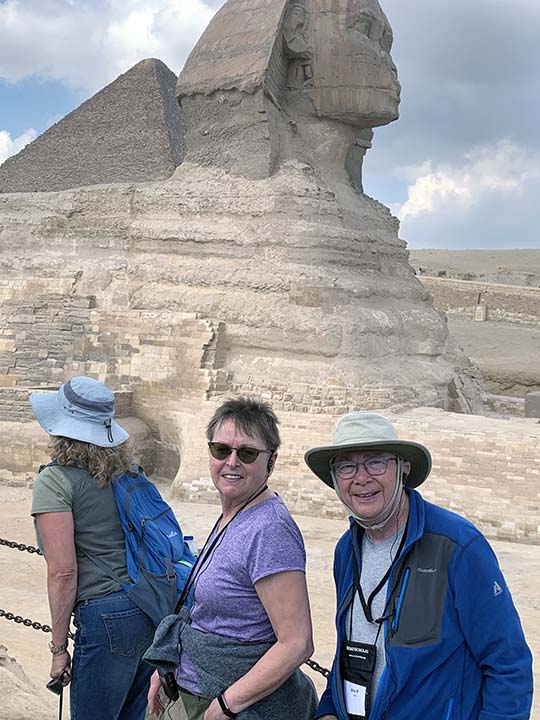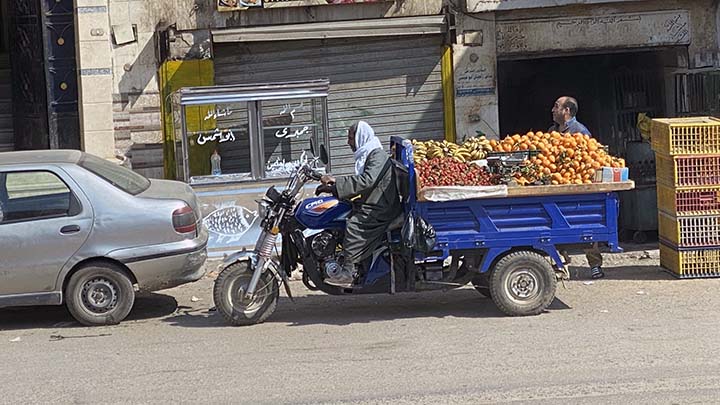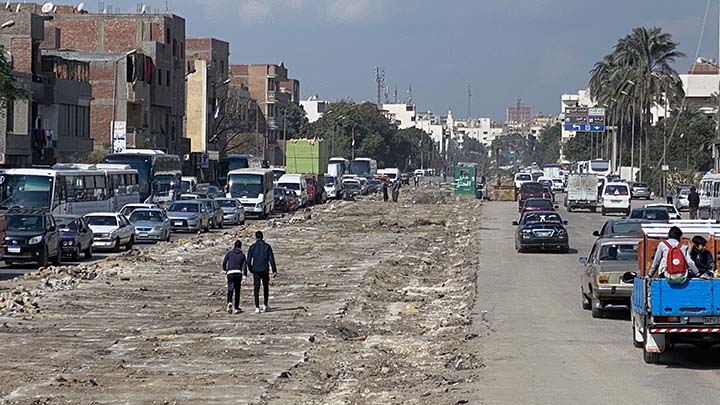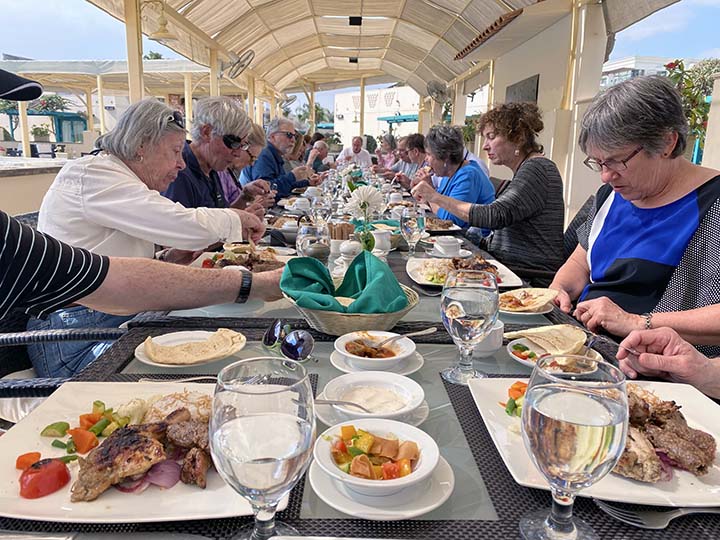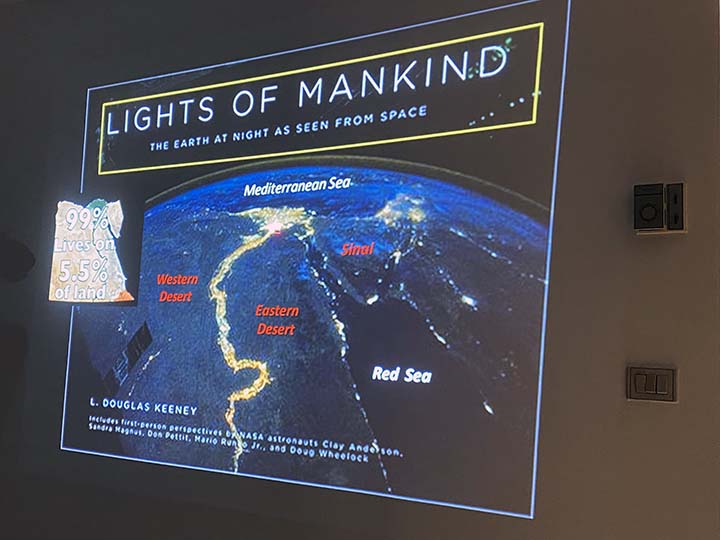|
At one point today our guide said, “Follow me to the Sphinx,“ and a woman in our group marveled, “Nobody has ever said that to me before.“ It was that kind of day.
There was some extra time after breakfast this morning, so the tourist decided to get some rest before heading out on his Egyptian adventure.
I don't know how he could be lazy though, with a view like this from his hotel room balcony.
I thought my view of the US Capitol from the roof of my condo when I lived in DC was magnificent, but this...holy cow.
This is our new guide for Egypt, Rafik Ezzi. Nice guy, knows his stuff But we miss you, Shari. Mo too!.
His Excellency Rafik had a distinctive way of speaking. Here are some clips to help us remember. If you watch it all you'll see Rafik break Bill's heart -- we won't be visiting Memphis.
Someday that will be the new Grand Egyptian Museum, which is now supposed to open in 2021. It should have been open for us on this trip, but you know, delays...
I've seen pictures all my life, and now here I am. Holy moley.
Are we all here?
Do we all have our tickets?
The tourist has his.
And there it is. The Great Pyramid. The Great Pyramid of Giza (also known as the Pyramid of Khufu or the Pyramid of Cheops) is the oldest and largest of the three pyramids in the Giza pyramid complex bordering present-day Giza in Greater Cairo, Egypt. It is the oldest of the Seven Wonders of the Ancient World, and the only one to remain largely intact. Egyptologists believe that the pyramid was built as a tomb for the Fourth Dynasty Egyptian pharaoh Khufu over a 20-year period concluding around 2560 BC. Initially standing at 481 feet, the Great Pyramid was the tallest man-made structure in the world for more than 3,800 years. It is estimated to weigh approximately 6 million tons, and consists of 2.3 million blocks of limestone and granite, some weighing as much as 80 tons. It was originally covered by limestone casing stones that formed a smooth outer surface; what is seen today is the underlying core structure, although a few casing stones can still be seen at the base. It was built by extracting huge stones from a quarry and lifting them into place, but there are varying scientific and alternative theories about the exact construction technique. There are three known chambers inside the Great Pyramid. The lowest chamber is cut into the bedrock upon which the pyramid was built and was unfinished. The so-called Queen's Chamber and King's Chamber are higher up within the pyramid structure. The main part of the Giza complex is a set of buildings that included two mortuary temples in honor of Khufu (one close to the pyramid and one near the Nile), three smaller pyramids for Khufu's wives, an even smaller "satellite" pyramid, a raised causeway connecting the two temples, and small mastaba tombs for nobles surrounding the pyramid.
The tourist is practically beside himself.
It's right here in the big modern city.
But it feels thousands of years old.
I brought only one pair of shoes, some very nice, perfectly comfortable New Balance sneakers. Trouble is, they are maybe 15 years old. And now they are coming apart. Will I make it to the end of the trip with these, or will I go shoe shopping in Egypt? Time will tell.
There's a door in this thing. Sure wish we could go inside.
I feel like I’m right at home. Some tour guides called to me when I took this picture. "You like our van?" "I'm from Memphis." They all laughed. They'd seen US Southerners do this before.
There are plenty of tourists. I would hate to be here in the high season.
Well it may be a door, but it doesn't exactly look inviting.
Actually you can go inside for a fee. We didn't have time.
We just stood outside and gazed up.
The tourist wandered higher than he was supposed to go and one of the self-important locals with a spurious "badge" yelled at him to come down.
He didn't want to, but rather than cause an international incident he clambered back down.
He's about to start clambering.
There he goes.
When the tourist was a kid he looked at the pyramids and figured those were just stairsteps and if he ever got to visit one he'd just walk up the steps to the top. Maybe it isn't that easy?
Nope, no walking to the top today.
It's a planned pile of boulders.
This guy is assigned to our bus. Really dressed up, isn’t he? Every time he moves, guns peek out from under his jacket. Egypt doesn't want its tourists to get terrorized by terrorists.
A pyramid.
Two pyramids.
Three pyramids.
Incredible view, isn't it?
The tourists is impressed.
He simply cannot believe he's standing her in this place, in this moment, and it's all going to come to an end in an hour or two and he'll probably never come here again, but holy moley he cannot believe this is all real.
Merely one of a gazillion tourists who have done this over the centuries and now he knows how they all felt.
Have I mentioned holy moley?
Let's not forget to mention there were trinkets for sale here.
And camel rides which the tourists was much to sophisticated to get suckered by. He should have let himself get suckered. Mayber he'll come back someday.
The Mastaba of Seshemnefer IV is a mastaba tomb in Cemetery GIS of the Giza Necropolis in Egypt. It dates from the early Sixth Dynasty (c. 2340 BC), and was built for the official Seshemnefer IV (LG 53). Five reliefs from the mastaba of Seshemnefer IV are on display in the Egyptian collection of the Roemer- und Pelizaeus-Museum Hildesheim. I didn't pay to go in.
I didn't pay to take this guy's picture either and he was pretty unhappy about it.
But along with several other Road Scholars I did pay to see the Giza Solar Boat Museum. It was constructed around 1985 and is dedicated to display the reconstructed Khufu solar ship. The Khufu ship is an intact full-size vessel from ancient Egypt that was sealed into a pit in the Giza pyramid complex at the foot of the Great Pyramid of Giza around 2500 BC. The ship is now preserved in the Giza Solar boat museum. The ship was almost certainly built for Khufu (King Cheops), the second pharaoh of the Fourth Dynasty of the Old Kingdom of Egypt. Like other buried Ancient Egyptian ships, it was apparently part of the extensive grave goods intended for use in the afterlife, and contained no bodies, unlike northern European ship burials.
And we're going to see it. But first we have to don special slippers so we don't track dust in from outside.
The Road Scholars are ready to see this thing.
The model hanging on the wall looks like a big mess.
And the exhibit that shows how everything is tied together doesn't help much.
But it is interesting to see ropes tied by people who lived about 4,500 years ago.
See? Original knots.
And there's a model of what the boat looked like back in its day. But what did it look like really?
Well first of all, it was big.
Khufu's ship is one of the oldest, largest and best-preserved vessels from antiquity. It measures 143 ft long and 19.5 ft wide. It was thus identified as the world's oldest intact ship and has been described as "a masterpiece of woodcraft" that could sail today if put into a lake, or a river. However, the vessel may not have been designed for sailing, as there is no rigging, or for paddling, as there is no room.
The tourist is amazed once again.
The ship was one of two rediscovered in 1954 by Kamal el-Mallakh – undisturbed since it was sealed into a pit carved out of the Giza bedrock. It was built largely of Lebanon cedar planking in the "shell-first" construction technique, using unpegged tenons of Christ's thorn. The ship was built with a flat bottom composed of several planks, but no actual keel, with the planks and frames lashed together with Halfah grass, and has been reconstructed from 1,224 pieces which had been laid in a logical, disassembled order in the pit beside the pyramid.
There's the prow.
And there's the cabin.
I’d sail on it.
I'd fit in that stateroom.
I mean, they say it would float as-is. C'mon!
I would look properly magnificent on this thing.
I love it!
So do the other Road Scholars.
Sadly, we must rejoin the real world, if this looks like the real world to you.
We're off to see the Sphinx.
The Great Sphinx of Giza, commonly referred to as the Sphinx of Giza or just the Sphinx, is a limestone statue of a reclining sphinx, a mythical creature.[1] Facing directly from West to East, it stands on the Giza Plateau on the west bank of the Nile in Giza, Egypt. The face of the Sphinx is generally believed to represent the pharaoh Khafra.
Cut from the bedrock, the original shape of the Sphinx has been restored with layers of blocks. It measures 240 ft long from paw to tail, 66 ft high from the base to the top of the head and 62 ft wide at its rear haunches/ It is the oldest known monumental sculpture in Egypt and is commonly believed to have been designed, sculpted, and constructed by ancient Egyptians of the Old Kingdom during the reign of the pharaoh Khafra (c. 2558–2532 BC).
The tourist fears he may be overcome by the amazements of this incredible day.
The Great Sphinx is one of the world's largest and oldest statues, but some basic facts about it, such as when it was built, by whom and for what purpose, are still subject to debate. It is impossible to identify what name the creators called their statue, as the Great Sphinx does not appear in any known inscription of the Old Kingdom and there are no inscriptions anywhere describing its construction or its original purpose. In the New Kingdom, the Sphinx was revered as the solar deity Hor-em-akhet (English: Horus of the Horizon), and the pharaoh Thutmose IV (1401–1391 or 1397–1388 BC) specifically referred to it as such in his Dream Stele. The commonly used name "Sphinx" was given to it in classical antiquity, about 2,000 years after the commonly accepted date of its construction by reference to a Greek mythological beast with the head of a woman, a falcon, a cat, or a sheep and the body of a lion with the wings of an eagle. (although, like most Egyptian sphinxes, the Great Sphinx has a man's head and no wings). The English word sphinx comes from the ancient Greek Σφίγξ (transliterated: sphinx) apparently from the verb σφίγγω (transliterated: sphingo / English: to squeeze), after the Greek sphinx who strangled anyone who failed to answer her riddle. You do know the riddle of the sphinx, don’t you? In Greek legend, the Sphinx devoured all travelers who could not answer the riddle it posed: "What is the creature that walks on four legs in the morning, two legs at noon and three in the evening?" The hero Oedipus gave the answer, "Man," causing the Sphinx's death. (Oh, c’mon: Four legs is a baby crawling, two legs is a man walking, three legs is an elderly man with a cane.)
Is there anything worth seeing down inside?
I dunno, not really.
The camels outside are more interesting.
Plus, you get to wonder what the Sphinx is thinking.
Twp great thinkers.
The Great Pyramid of Giza and the Sphinx. This has been a great day.
Gordon and (help, name, sorry) and the Sphinx. But if you'd turned your nametag like Gordon did there'd be no problem. :-)
At least I remember the name of the tourist.
Carl and Dona and the Sphinx. See how it helps to have your nametags turned the right way?
There he is. She is.
There's lots more to the Sphinx than I'd realized.
It's got an actual butt.
Not much of a nose, though.
Stephanie and Mike and the Sphinx. I got their names right!
Now we must head back to the hotel through Cairo traffic. This took a while.
But there were nice sights along the way.
Cairo is not a beautiful city.
They do have bananas, though.
And the promise of a nice museum someday.
Dinnertime!
The Road Scholars do enjoy their food.
Hany Hamroush, professor of geology at Cairo University, was our guest speaker tonight. He was fantastic. His presentation was maybe the best Road Scholar lecture I have heard in all my trips. He told us all about the Nile, how it allowed civilization — the world’s first nation state — to flourish in Egypt, and how its problems are being managed today. Fascinating stuff.
Now I have to go to bed. We have a 2 AM wake up call scheduled so we can catch an early flight to Aswan.
|

